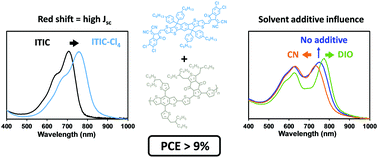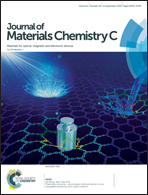A tetrachlorinated molecular non-fullerene acceptor for high performance near-IR absorbing organic solar cells†
Abstract
We detail the physical properties and organic photovoltaic (OPV) performance of a tetrachlorinated fused ring non-fullerene acceptor. Introduction of chlorine atoms red-shifts the optical absorption out to 850 nm leading to low energy photocurrent generation in solar cell devices using the donor polymer PBDB-T. Processing films with different volatile solvent additives affects the active layer morphology and open-circuit voltage (Voc). The best solar cells exhibit power conversion efficiencies over 9%.

- This article is part of the themed collection: Editor’s Choice: Organic Photovoltaics


 Please wait while we load your content...
Please wait while we load your content...